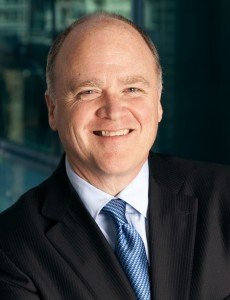Amping up the drumbeat on potential problems with alternative capital providers, reinsurance industry executives aired critical views about their enduring competitors recently with words like “abusive” and “distrust” peppering their remarks.
“I think the likelihood of it [alternative capital] evolving into something less stable or abusive is real,” said XL Group CEO Mike McGavick said during the Bermuda Monetary Authority’s 2014 insurance seminar, according to an account in a media statement from BMA.
Worried about the spillover effect to the traditional reinsurance market, McGavick said the possibility of instability and abuse “is the thing we really all ought to be thinking about—because that drives to the heart of trust in the system and we don’t need distrust in our system,” the statement reported.

He continued: “There’s opportunity for there to be new clashes in exposure that are unrecognized and when they come due are unpayable.” Going a step further, McGavick drew a parallel the mortgage-backed securities debacle. “In essence this is the story of the real estate crisis—and that is the risk here because the risk is being removed from those that took the risk.
“The advantage of the integrated model is you’re betting with your money. That changes how you feel about it.”

John Nelson, chairman of Lloyd’s of London, agreed. “It’s going to be a continuous challenge, that as the alternative capital market develops, the temptation to detach the risk from the capital becomes ever greater,” he said.
Returns on some securities will “look really alluring” but as the development continues, so does the potential for destabilization “exactly as happened in subprime mortgages,” he said, according to BMA’s account of the meeting that drew 400 seminar attendees to the Fairmont Southampton resort to hear the executives.
Countering McGavick and Nelson with a view from the alternative capital provider’s side, Frank Majors, co-founder and principal, Nephila Capital conceded the possibility for “abuse or misuse, or being taken too far in the future.”
Currently, however, the main effect of alternative capital “is to actually de-lever the industry significantly. So it’s very different right now, in this stage of development…from the mortgage securitization which was a process of adding leverage. What it really is, is taking a risk off of levered balance sheets onto unlevered balance sheets.”
Majors went on to suggest that alternative capital is providing “access to deeper pools of capital,” which should in fact “add stability, unless it’s abused in some way.”
Parallels between mortgage-backed securities and insurance-linked securities have been made before, notably by one of the more outspoken critics of alternative capital in the reinsurance industry, General Re Corp. CEO Franklin “Tad” Montross. In his remarks, Montross has generally focused on the allure of high MBS yields rather than the disconnect between the risk and the capital backing the risk.
McGavick’s other point about the potential unpaid claims under ILS contracts to be reflected back on the reinsurance industry has also surfaced in other previous industry forums, including the Standard & Poor’s Annual conference in June. At that meeting John Charman, CEO of Endurance Specialty Holdings, was one of several speakers who expressed concern about litigation from third-party capital providers that might harm the traditional reinsurance industry.
More recently, Martin Hacala, global claims manager for Gen Re in Stamford, picked up the litigation theme with a real example in a blog item on Gen Re’s website titled, Non-Traditional Reinsurance: Lessons Learned the Hard Way.
Describing the details of the case Mariah Re Ltd v. American Family Mutual Insurance Co., in which a catastrophe bond provider essentially disputed the process used to arrive at loss estimates, Hacala asks, “How attractive is alternative capital if it doesn’t stand with you when you need it most?”
In fact, the outcome of the case, so far, has been favorable to the reinsurance buyer, Hacala notes, reporting that Southern District of New York granted the defendants motion to dismiss this case pitting Mariah Re, a catastrophe bond facility, against American Family, the buyer of $100 million in reinsurance coverage, as well as AIR Worldwide and ISO’s Property Claim Services, who were involved in the calculation of losses.
Noting that the story isn’t over—Mariah has appealed the court ruling that it has to pay up—Hacala goes on to stress that the dispute here does not center on the amount American Family sought to recover but rather on “the process by which PCS issued and revised…loss estimates, the process by which AIR calculated Mariah’s payment obligation, and the process by which the bank released the funds to American Family.”
This couldn’t happen with traditional reinsurance contract arrangement, he suggests.
“Mariah’s claims about the purportedly improper procedures followed by the parties are akin to a traditional reinsurer complaining about the way the ceding company handled the claim. Under follow the fortunes principles, however, a traditional reinsurer is not permitted to second guess the ceding company’s reasonable, good faith claims handling decisions. In fact, that’s one of the fundamental tenets of reinsurance,” he writes.
Hacala continues: “Mariah didn’t lose in the district court because of a legal doctrine that favors ceding companies over reinsurers. It lost primarily because a close reading of the contract did not support its core claims.
“A few changes to the contract and the outcome might have been different. That’s hardly comforting to the next insurer that enters into a similar deal.”
He concludes that the “essential lesson” of the case is to expose “a deep flaw under the ostensibly attractive exterior of nontraditional reinsurance products—the greater uncertainty of collecting and keeping claim payments.”
“This is largely because these products often do not afford the insurer the protections against such disputes that are afforded by traditional reinsurance.
“It also may be that investors in insurance-linked securities don’t have the same appetite for paying losses as a reinsurer does,” he writes.
Sources: BMA, Gen Re





















 Truckers Who Fail English Tests Are Pulled Off Roads in Crackdown
Truckers Who Fail English Tests Are Pulled Off Roads in Crackdown  The Future of Knowledge in Insurance: From Training to AI-Powered Productivity
The Future of Knowledge in Insurance: From Training to AI-Powered Productivity  What to Expect in 2026: U.S. P/C Results More Like 2024
What to Expect in 2026: U.S. P/C Results More Like 2024  The Latest Launches from Allstate, WTW, Whisker Labs
The Latest Launches from Allstate, WTW, Whisker Labs 







